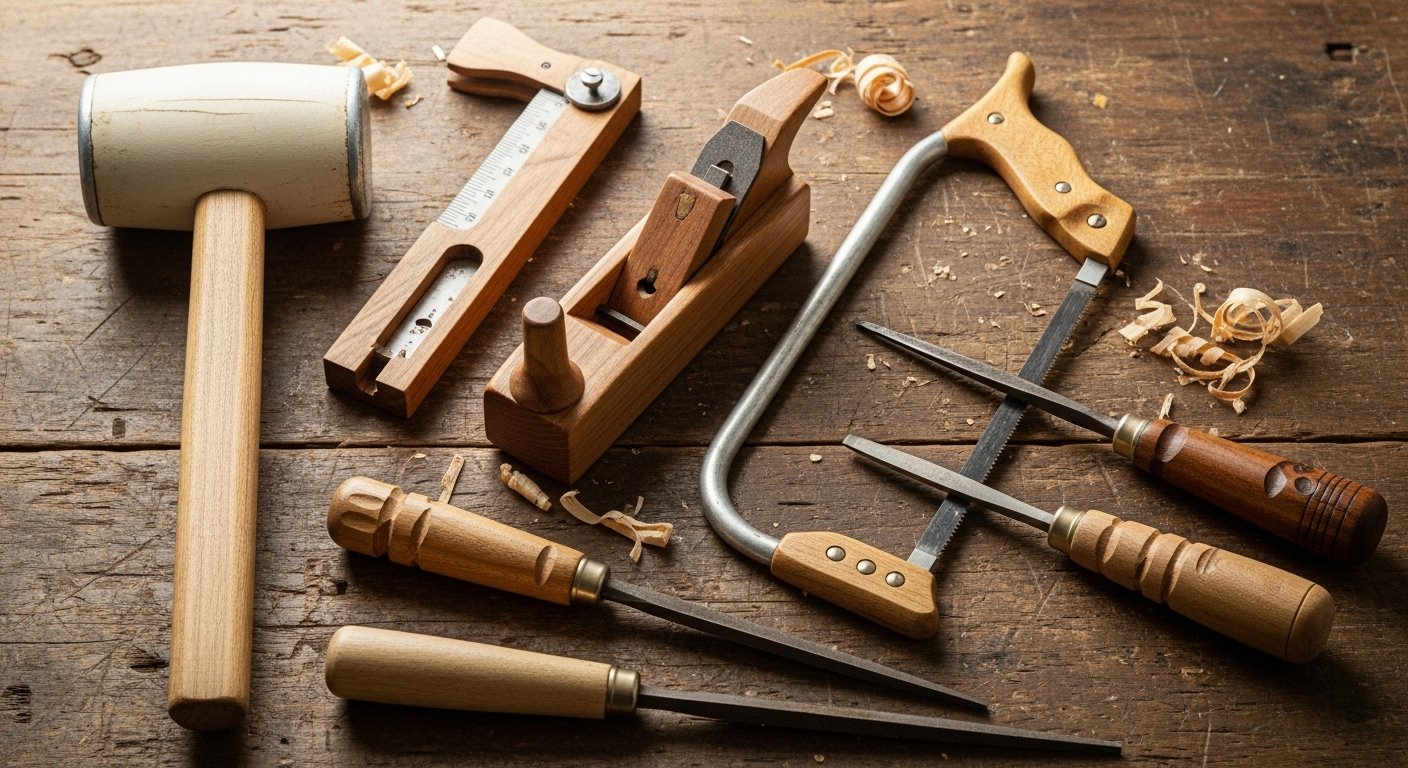Woodworking is a rewarding craft, offering the satisfaction of creating beautiful and functional items with your own hands. However, setting up a comprehensive workshop can often seem daunting, especially with the cost of acquiring numerous tools. What if you could equip your workspace with essential items without a significant financial outlay? The answer lies in crafting your own homemade woodworking tools. This guide is designed for students and aspiring woodworkers, offering practical, step-by-step insights into building a variety of indispensable DIY woodshop tools right in your own home. By leveraging readily available materials like scrap wood and basic hardware, you can unlock incredible potential and develop a deeper understanding of the tools you use.
The enthusiasm for DIY projects, particularly in woodworking, continues to surge. The global DIY woodworking tools market, for instance, is estimated at an impressive $15 billion in 2025, with a projected Compound Annual Growth Rate (CAGR) of 6% from 2025 to 2033. The broader Home Improvement and DIY segment within the woodworking tool market alone accounted for an estimated USD 12.67 billion in 2023 and is expected to grow at a CAGR of 4.0% through 2032. This trend underscores a widespread desire among enthusiasts to engage with their craft on a more personal and cost-effective level. By making your own tools, you’re not just saving money; you’re joining a thriving community that values ingenuity and self-sufficiency.
Building your own tools offers a wealth of benefits beyond just saving money. It’s an empowering journey that enhances your skills and understanding of woodworking from the ground up.
- Cost-Effectiveness: This is often the primary motivator. By utilizing scrap wood and hardware that you might already have, you can create functional tools for a fraction of the cost of buying them. This makes woodworking more accessible, especially for beginners or those working with a budget. You’ll discover that many highly effective tools fall into the category of cheap woodworking tools DIY.
- Customization: When you make custom woodworking tools, you tailor them precisely to your needs, your hands, and the specific tasks you frequently perform. This level of personalization is simply not possible with off-the-shelf items, leading to tools that are more comfortable and efficient for *you*.
- Deeper Understanding: The process of building a tool inherently teaches you about its mechanics, its purpose, and how it interacts with wood. This knowledge makes you a more skilled and intuitive woodworker. You’ll understand the ‘why’ behind its design, which is invaluable.
- Sustainability: Giving new life to scrap wood not only reduces waste but also provides a sense of accomplishment. It’s a sustainable approach to expanding your workshop.
- Skill Development: Each tool-making project is a woodworking project in itself, sharpening your measuring, cutting, and assembly skills.
The overall DIY tools market, a testament to this self-reliance, was valued at USD 940.42 billion in 2024, projected to reach USD 973.34 billion in 2025 and further escalate to USD 1281.69 billion by 2033, with a strong CAGR of 3.5%. This growth highlights a fundamental shift towards hands-on engagement and resourcefulness. Moreover, a 2016 survey revealed that 5.5 million people in the United States participate in woodworking as a hobby, spending an average of $1,000 per year on supplies, tools, wood, and equipment, collectively generating $5.5 billion in annual sales. Imagine the savings and satisfaction when you can make many of these essential items yourself!
Before diving into any woodworking project, including making your own tools, safety must be your absolute priority. Even with simple hand tools or homemade jigs, understanding and mitigating risks is crucial. Always wear appropriate personal protective equipment (PPE), such as safety glasses, to protect your eyes from flying debris and dust. Keep your workspace clean and clutter-free to prevent tripping hazards. Focus on your task, avoid distractions, and ensure you understand how each tool functions, whether it’s homemade or a store-bought item. For comprehensive safety guidelines, it’s always wise to consult authoritative resources like the Occupational Safety and Health Administration (OSHA) [3], which provides detailed information on woodworking safety practices.
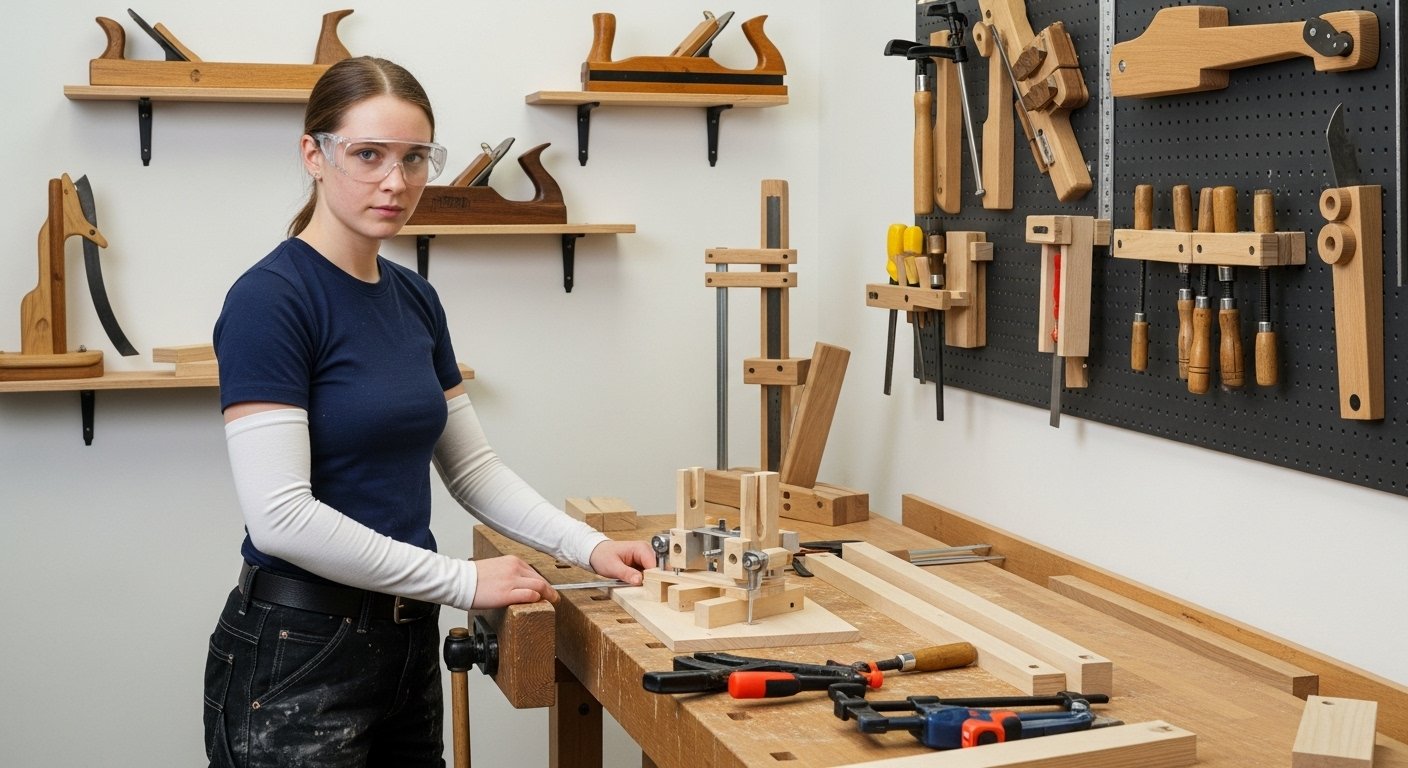
One of the most exciting aspects of DIY woodworking is the ability to create a wide array of useful tools for your workshop. Many of these projects are straightforward and can significantly enhance your woodworking capabilities. Let’s explore some of the most rewarding shop-made tools for woodworkers.
You might be surprised at how many fundamental hand tools can be constructed with minimal effort and materials. These beginner woodworking tools homemade are excellent starting points for any aspiring craftsperson.
A Wooden Mallet is an essential striking tool in any workshop, used for driving chisels, seating joints, or persuading stubborn pieces of wood without marring them. Unlike a metal hammer, a wooden mallet’s softer face won’t damage the handles of your chisels or the surfaces of your workpieces. Making one is a fantastic project for learning basic joinery. You’ll typically construct it from a dense hardwood like oak or maple, fashioning a head with a mortise and a comfortable handle with a tenon to fit. The weight and balance can be customized to your preference, making it a truly personalized homemade woodworking tool.

A Marking Gauge is crucial for laying out accurate lines parallel to an edge, essential for joinery and precise cuts. This tool typically consists of a beam, a fence (or stock), and a sharp pin or wheel. You can easily craft a functional Marking Gauge using a piece of hardwood for the beam, a block of wood for the fence, and a hardened nail or a small piece of steel rod for the marking pin. The fence slides along the beam and is secured with a wedge or a simple thumbscrew, allowing you to set precise measurements. It’s an excellent example of how homemade marking tools can be incredibly effective.
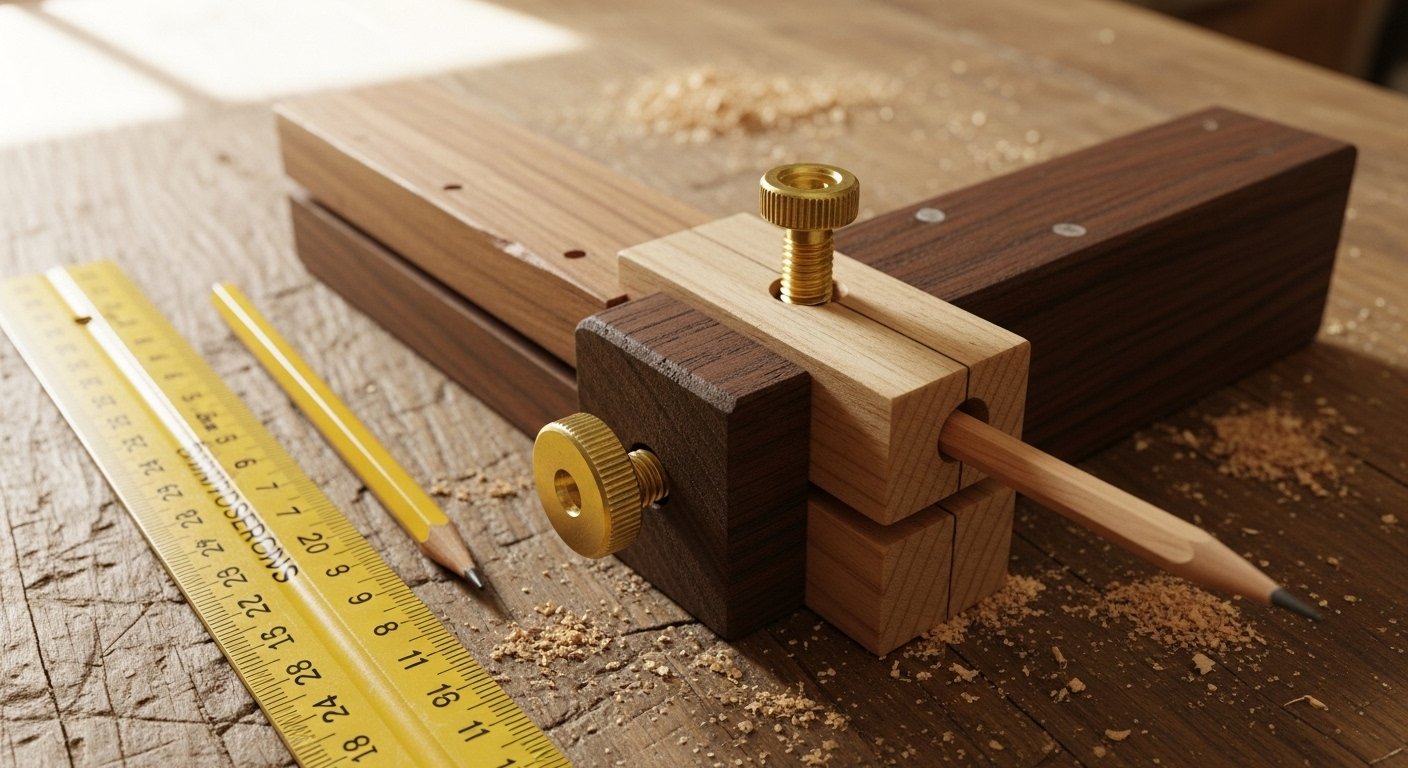
Accuracy is paramount in woodworking, and a square is one of your most fundamental tools for checking and marking 90-degree angles. While metal squares are common, a highly accurate DIY Try Square can be made from stable plywood or hardwood. The key is to ensure the blade and stock are perfectly perpendicular. By carefully jointing the edges and assembling the two pieces, you can create a reliable square. You can even use a known accurate reference square to check and refine your homemade version, demonstrating how to make hand tools for woodworking that meet high standards.
Achieving smooth finishes often requires sanding in tight spaces or on detailed profiles where power sanders can’t reach. This is where DIY sanding tools like sanding sticks and blocks shine. These are simply pieces of scrap wood shaped to various profiles (flat, rounded, angled) with sandpaper glued to them. You can create a collection of these in different grits and shapes, making it easy to tackle any sanding challenge. They are prime examples of cheap woodworking tools DIY that significantly improve your workflow.
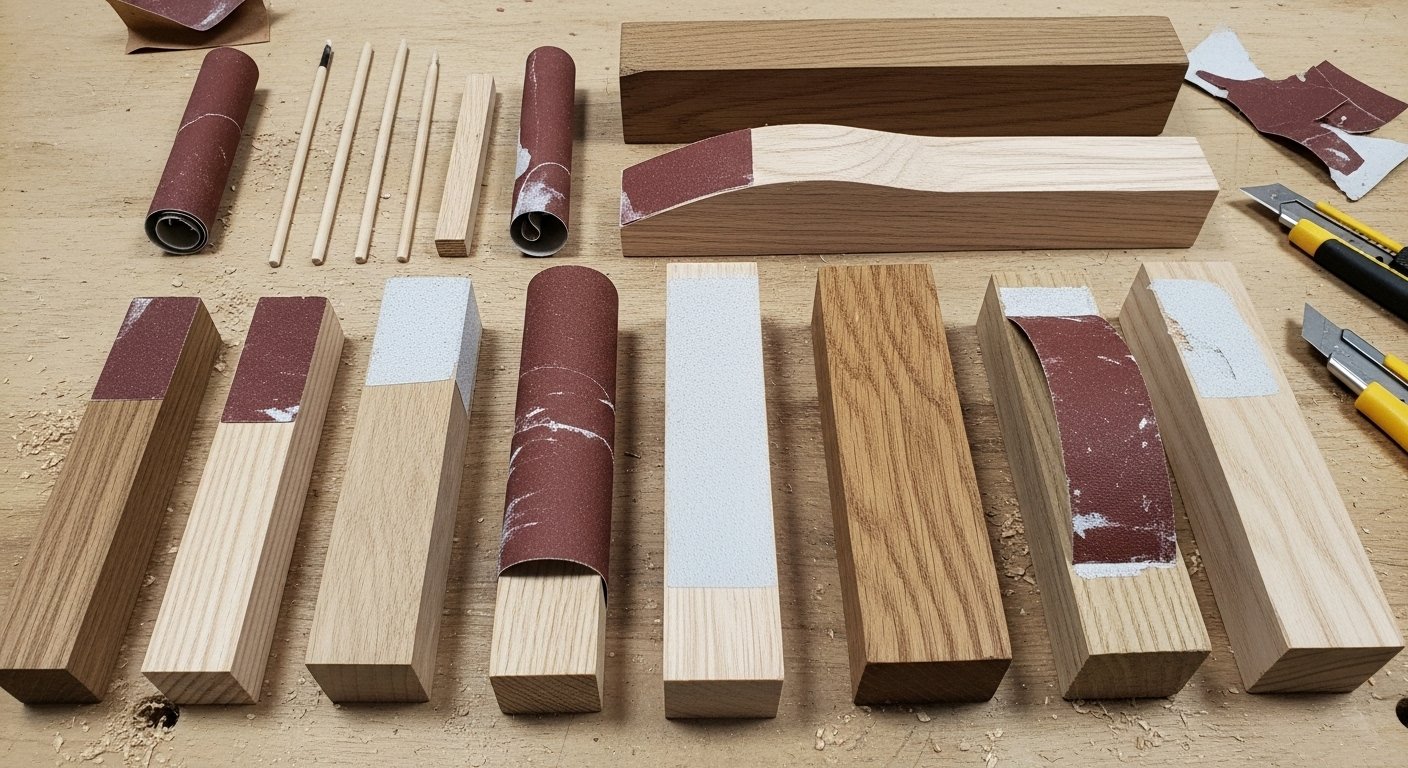
A Bench Hook is a simple yet incredibly useful woodworking appliance that dramatically improves safety and accuracy when cutting small pieces with a hand saw. It provides a stable platform and a fence to register your workpiece against, preventing it from slipping. Typically made from three pieces of scrap wood, it hooks over the edge of your workbench. This allows you to saw small components without clamping them, keeping your hands away from the saw blade. It’s a foundational piece of any DIY woodshop tools collection.
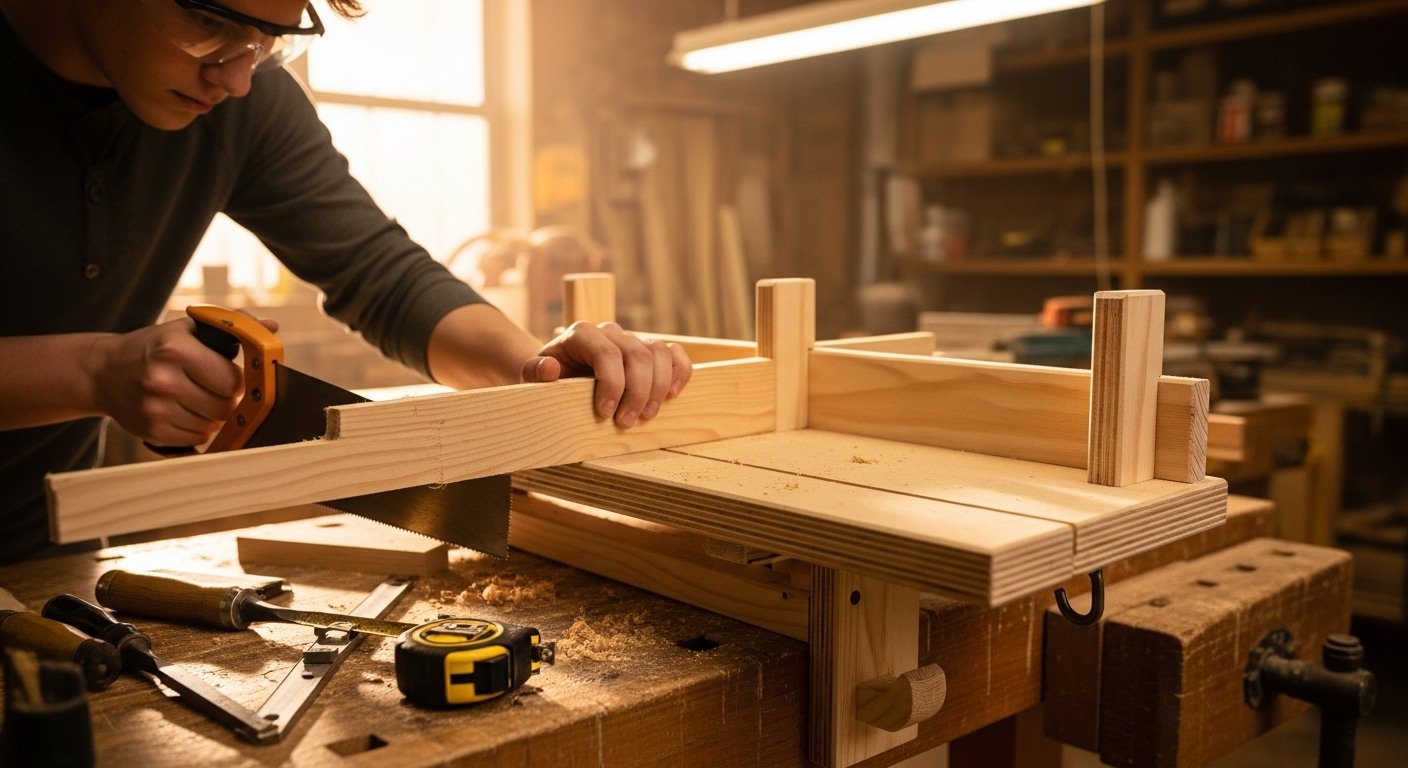
Jigs and fixtures are the unsung heroes of precision woodworking. These custom aids help guide tools, hold workpieces, and ensure repeatable accuracy for complex tasks. They transform common processes, allowing you to achieve professional-level results with simpler tools. Building woodworking jigs is a skill that will profoundly impact the quality and efficiency of your projects. Many of these can be built using readily available scrap wood & hardware, making them budget-friendly woodworking tools.
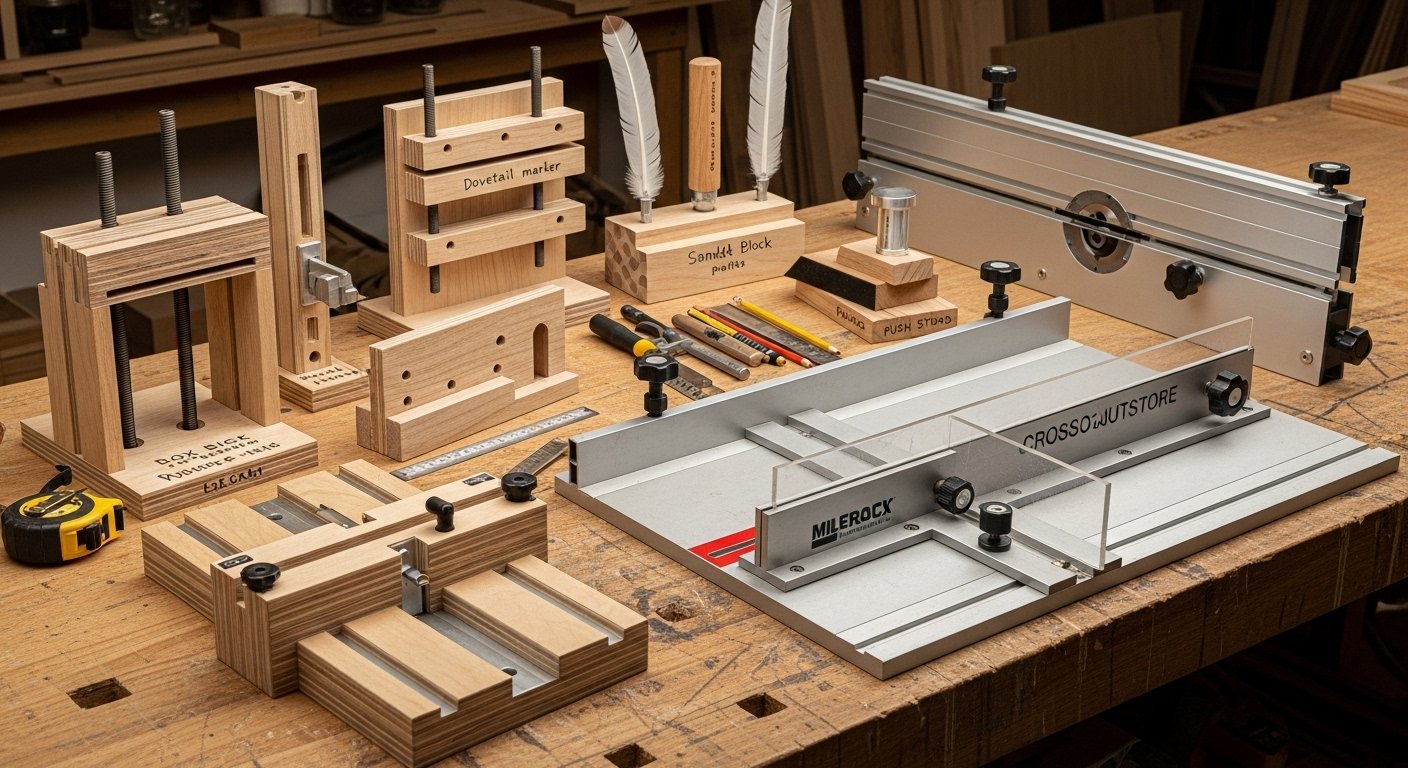
Every woodworker knows you can never have too many clamps! Luckily, you can build your own clamps to supplement your collection. These homemade clamps woodworking solutions are excellent for securing workpieces during glue-ups, machining, or assembly. For a comprehensive look at commercial clamp types, consider reading about essential woodworking clamps.
- Wooden F-style Clamps: These can be constructed from hardwood and threaded rods or bolts, offering significant clamping pressure. The beauty of wooden clamps is their ability to conform slightly to irregular shapes and provide a soft clamping surface.
- Wedge Clamps: Simple and incredibly effective for holding boards together, especially in panels. These involve a fixed jaw and a movable wedge that applies pressure, creating a strong hold with minimal parts. They are prime examples of tools you can make from scrap materials.
Shop-built sleds and guides are game-changers for accurate and safe cutting. They are among the most valuable woodworking jigs and fixtures you can create.
- Miter Sled: This jig allows you to make precise crosscuts and miter cuts on a table saw or even with a circular saw guided by a straight edge. Constructed from a plywood base and fences, it ensures consistent angles and reduces tear-out.
- Jigsaw Crosscut Sled: A simple sled for your jigsaw can dramatically improve its accuracy for crosscuts. It typically consists of a base with a fence and a guide for the jigsaw’s shoe, enabling straight and square cuts.
- Drill Press Jig/Guide: While a full drill press is beyond the scope of homemade tools, you can create a jig that allows you to use a hand drill to make perfectly perpendicular holes. This jig holds the drill securely and guides it vertically, mimicking the function of a drill press for precise drilling tasks. These DIY workbench attachments greatly expand the utility of your existing tools.
A router is a versatile tool, and its capabilities are greatly expanded when mounted in a table or used with a dedicated fence. Building a Router Table Fence from plywood or MDF is a highly rewarding project. It provides a straight edge for routing operations, allowing you to create consistent dados, rabbets, and profiles. You can even incorporate dust collection ports and adjustable outfeed fences into your design, making it a powerful addition to your shop-made tools for woodworkers. Many simple homemade router table plans focus on building just the fence system, which can be clamped to any sturdy workbench or a basic tabletop you’ve constructed.

Safety in the workshop is paramount, and many simple, effective aids can be built at home to make your woodworking safer and more enjoyable. These workshop hacks are invaluable.
Keeping your hands away from cutting tools, especially rotating blades, is non-negotiable. Custom Push Sticks and Push Blocks are easy to make from scrap wood and are essential for safe operation of saws and routers. Design them with comfortable handles and effective gripping surfaces to safely guide workpieces through cuts. These are some of the most basic, yet critical, homemade woodworking tools you can create to protect yourself.
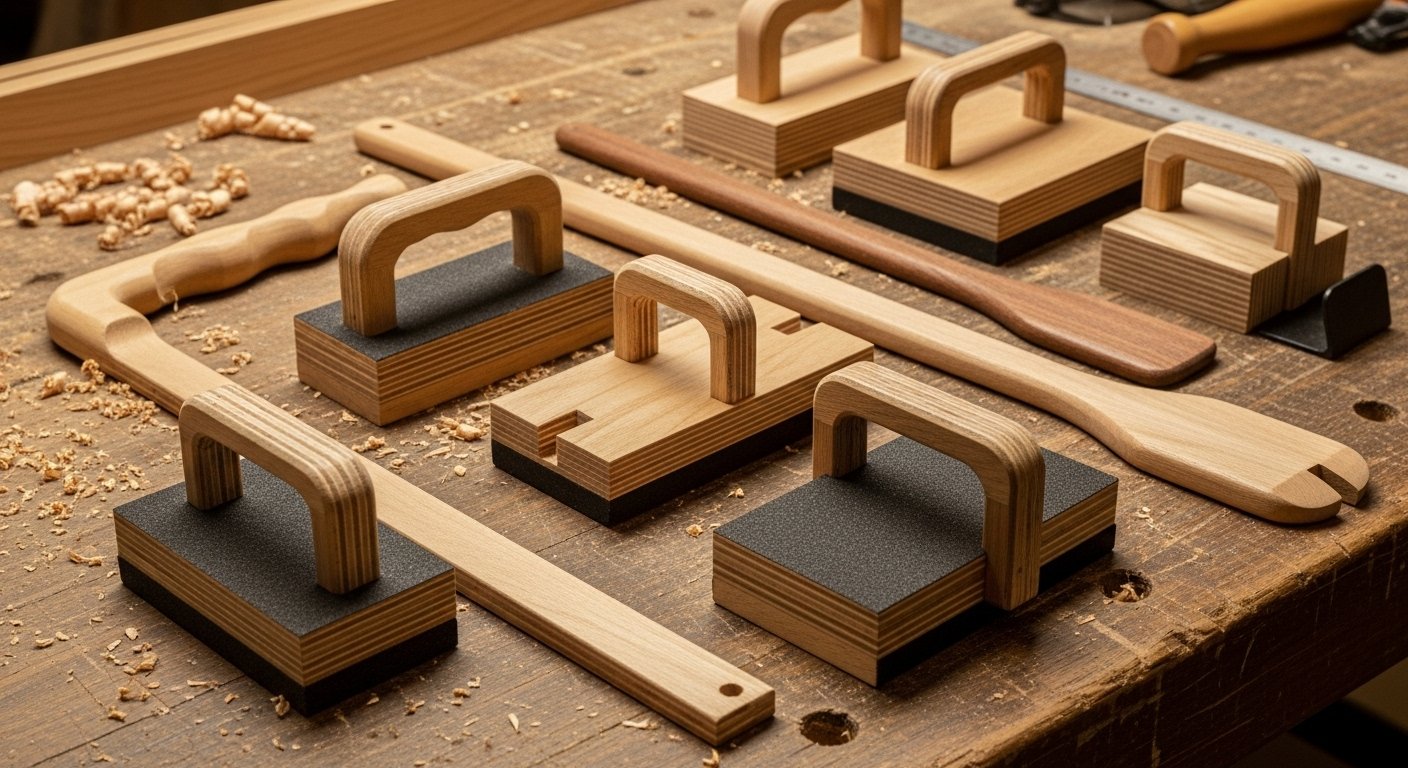
Bench cookies (small, non-slip supports) and various bench stops elevate your workpiece off the bench, allowing for easier clamping, sanding, and finishing without marking your bench or the workpiece. These are simple to make from scrap wood and can have non-slip material attached to the bottom. They are excellent woodworking hacks for improving efficiency.
A tidy shop is a safe and efficient shop. You can easily build various organizers from scrap wood & hardware to keep your tools, sandpaper, and, ironically, your scrap wood, organized. A sturdy Sawhorse is another simple but incredibly useful shop utility. It provides a portable and stable support for cutting larger stock, assembling projects, or even serving as an auxiliary workbench. These are fundamental items that contribute significantly to a functional workspace.
As you delve deeper into creating these shop-made tools for woodworkers, you’ll find that each project not only yields a useful item but also sharpens your overall woodworking abilities. The principles you learn – precision in measurement, careful assembly, and understanding material properties – are transferable to all your future projects. Whether you are looking for 10 essential woodworking hand tools for beginners or seeking guidance on essential woodworking tools for small shops, remember that the ability to make custom woodworking tools is a superpower.
Embrace the process of using woodworking tools from scrap materials. It fosters creativity and a problem-solving mindset. Don’t be afraid to experiment with designs and adapt them to your specific needs. The journey of making your own tools is just as rewarding as making furniture or other woodworking projects.
The history of woodworking itself is deeply intertwined with the evolution of handmade tools, dating back to early humans who first shaped wood with stone and bone [2]. From the ancient Egyptians who used copper and bronze tools to craft intricate pieces, to the revered Chinese carpenter Lu Ban whose legacy still influences craftsmen today, the craft has always relied on ingenuity in tool-making [2, 7, 9]. By building your own, you connect with a rich heritage of craftsmanship and innovation.
Embarking on the journey of creating your own homemade woodworking tools is a fantastic way to equip your workshop, enhance your skills, and connect more deeply with the craft. From simple marking gauges and wooden mallets to sophisticated woodworking jigs and fixtures, the possibilities are vast and incredibly empowering. These budget-friendly woodworking tools prove that a fully functional and precise workshop doesn’t require a massive investment. Instead, it thrives on creativity, resourcefulness, and a willingness to build things with your own hands. So gather your scrap wood, unleash your ingenuity, and start building the tools that will build your future projects. Happy woodworking!
Key Takeaways
- Crafting homemade woodworking tools offers significant cost savings, customization options, and a deeper understanding of tool function.
- Essential DIY tools like wooden mallets, marking gauges, and sanding blocks are simple to make from scrap materials.
- Building woodworking jigs and fixtures, such as clamps and sleds, greatly enhances precision and safety in the workshop.
- Prioritizing safety with homemade aids like push sticks and bench hooks is crucial for any woodworking endeavor.
- Embracing DIY tool-making fosters creativity, problem-solving skills, and connects woodworkers to a rich historical tradition.
